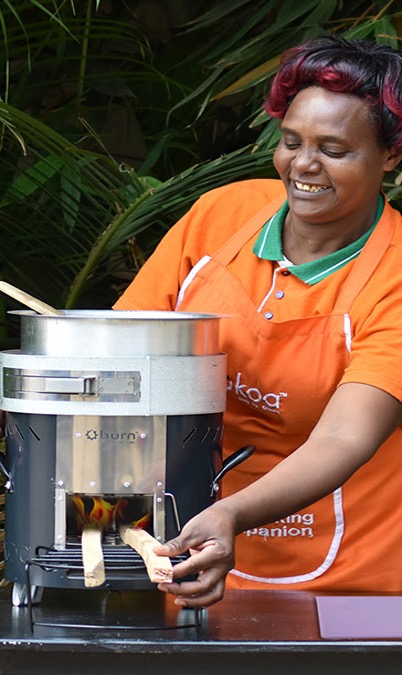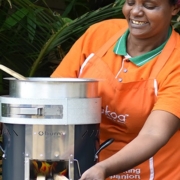How to Achieve 50% Thermal Efficiency in a Rocket Stove

In a recent BURN newsletter it was announced that the natural draft Kuniokoa stove with a new pot skirt achieved 51.3 % thermal efficiency. That’s Tier 5, the highest score on the voluntary tiers of performance. Achieving great thermal efficiency involves improving heat transfer efficiency which is summarized in the acronym TARP-V: Increase Temperature, Area, and Radiation, use narrow channel gaps to achieve Proximity, and increase the Velocity of the gases flowing past the pot without decreasing the temperature.
Making a clean burning fire does not help very much to increase thermal efficiency. Even 97% combustion efficiency is very smoky.
How can your stove get around 50% thermal efficiency?
- The BURN stove is very light weight, weighing in at around 3 kilos. Thermal mass in the stove body absorbs heat from the fire lowering the temperature of the gases trying to heat the water in the pot. MAKE THE GASES AS HOT AS POSSIBLE! Hotter gases in narrow channels flowing past the bottom and sides of the pot thin the boundary layer of still air next to the pot and result in better heat transfer efficiency. The insulation in the BURN stove is 15mm of trapped air – a cylinder surrounds the riser in the Rocket combustion chamber.
- The channel gaps on the bottom and sides of the pot can be 6mm. 10cm or higher pot skirts are better. It’s great if the pot skirt is as high as the water level in the pot.
- Small, kiln dried sticks make a lot of flame (and smoke). Small sticks (we used 1cm by 2cm in a recent test) create hotter fires and gases, using less fuel compared to burning larger sticks. The hotter gas temperatures get a higher percentage of the heat into the pot.
- A big pot has more surface area and can be a better heat exchanger. Dr. H. S. Makunda found that larger pots (32cm in diameter) could score in the 50% range, while smaller pots (25cm) tended to get around 40% thermal efficiency. (H. S. Mukunda, CURRENT SCIENCE, VOL. 98, NO. 5, 10 MARCH 2010).
- Don’t make a big fire. A moderate fire (3 to 5Kw) is better matched to family sized pots. (Prasad, Some studies on open fires, shielded fires and heavy stove, Eindhoven, 1981)
- A hot start test usually adds something like 5% to the thermal efficiency. A cold start test transfers more of the heat from the fire into the stove body.
We built a Rocket stove that combined these characteristics. The stove top had 6mm high pot supports and the 6mm channel gap pot skirt was 10cm high. The pot had a diameter of 30cm. We used very light weight ceramic fiber insulation around the combustion chamber. The stove weighed 2.9 kilos and was 24cm high and 32cm wide. We tested it by burning five kiln dried 1cm by 2cm sticks in a hot, small fire that started quickly. The Rocket stove smoked like crazy at a firepower of around 4.5Kw, but the thermal efficiency from one high power, hot start test was 52.7%.
This week we will see what happens when we use the same Rocket stove/big pot with a Jet-Flame that should increase the Temperature of the gases and their Velocity.




Leave a Reply
Want to join the discussion?Feel free to contribute!